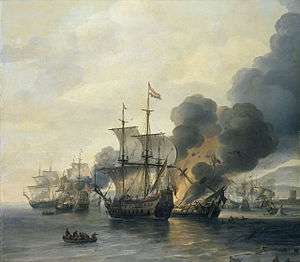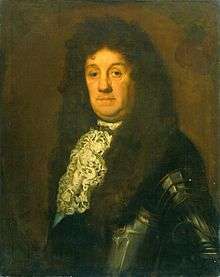Cornelis Tromp
| Cornelis Maartenszoon Tromp | |
|---|---|
 Portrait of Cornelis Tromp by Peter Lely | |
| Born |
3 September 1629 Rotterdam, Holland, Dutch Republic |
| Died |
29 May 1691 (aged 61) Amsterdam, Holland, Dutch Republic |
| Buried at | Oude Kerk, Delft, Netherlands |
| Allegiance |
|
| Service/branch |
|
| Years of service | 1643–1691 |
| Rank |
Admiral General (Denmark) Lieutenant Admiral General (Dutch Rep.) |
| Battles/wars |
First Anglo-Dutch War Second Anglo-Dutch War Third Anglo-Dutch War Scanian War |
| Relations | Maarten Tromp |
Cornelis Maartenszoon Tromp (3 September 1629 – 29 May 1691) was a Dutch naval officer. He was the son of Lieutenant Admiral Maarten Tromp.[lower-alpha 1] He became Lieutenant Admiral General in the Dutch Navy and briefly Admiral General in the Danish Navy. He fought in the first three Anglo-Dutch Wars and in the Scanian War.
Biography
Early life

Cornelis Maartenszoon Tromp was born on 9 September 1629 in Rotterdam, in the county of Holland, the historically dominant province of the Dutch Republic. He was the second son of Maarten Harpertszoon Tromp and Dina Cornelisdochter de Haas. His name Maartenszoon, sometimes abbreviated to Maartensz., is a patronymic and means "son of Maarten". He had two full brothers, Harper and Johan.[1]
In 1633, when he was only four years old, his mother died. His father remarried in 1634 and again in 1640. The two marriages together brought Tromp four half brothers and five half sisters.[2]
His father had made career as an officer for the Admiralty of the Maze. After a conflict with Lieutenant-Admiral Philips van Dorp in 1634 Maarten Tromp left the fleet starting to work as a deacon. After Van Dorp was removed from his position[2] in 1637, his father became Lieutenant Admiral and supreme commander of the Dutch Navy.
In 1642, Cornelis Tromp was sent to Harfleur in France to learn to speak French from a Calvinist preacher.
Early navy career

On 1 September 1643, he joined his father on his flagship the Aemilia. In September 1645, he was appointed as lieutenant. On 22 August 1649, he was made a full captain.
He served in the First Anglo-Dutch War, fighting in the Battle of Leghorn, but wasn't given command of the Mediterranean fleet after the death of Johan van Galen, only being promoted to Rear-Admiral with the Admiralty of de Maze on 11 November 1653 after the death of his beloved father Maarten.
In 1656, he participated in the relief of Gdańsk (Danzig). In 1658, it was discovered he had used his ships to trade in luxury goods; as a result he was fined and not allowed to have an active command until 1662. Just before the Second Anglo-Dutch War, he was promoted to Vice-Admiral on 29 January 1665; at the Battle of Lowestoft, he prevented total catastrophe by taking over fleet command to allow the escape of the larger part of the fleet.
Lieutenant Admiral
_-_Nightly_battle_between_Cornelis_Tromp_and_Eward_Spragg_(Willem_van_de_Velde_II%2C_1707).jpg)
Gaining sudden popularity, he was temporarily given supreme command as Lieutenant Admiral of the confederate fleet on 23 July 1665, but had to give up this function (but not rank) the next month in favour of Lieutenant Admiral Michiel de Ruyter; he fought, having been transferred to the Admiralty of Amsterdam on 6 February 1666, under the latter in the Four Days Battle and the St. James's Day Battle. As this failure off Nieuwpoort in August 1666 was imputed to him by De Ruyter, he was dismissed, at the same time, being under the suspicion of plotting to overthrow the government, but he returned in April 1673, after the Orangists seized power, to fight against the French and English navies in the Third Anglo-Dutch War where he participated in the last three fleet actions under Lieutenant-Admiral-General Michiel de Ruyter, distinguishing himself in the double Battle of Schooneveld and the Battle of Texel in August 1673 fighting out an epic duel with his personal enemy Edward Spragge, who drowned. During this war, his flagship was the Gouden Leeuw, of 82 cannon.

He was closely involved in the murder of Johan de Witt and Cornelis de Witt in 1672.[3] In 1675 he was created an English baronet and a Dutch erfridder by Charles II of England but he refused an honorary doctorate when visiting Oxford.
Danish Navy
On 8 May 1676, he became Admiral-General of the Danish navy and Knight in the Order of the Elephant; in 1677 Count of Sølvesborg (then a Danish nobility title). He defeated the Swedish navy in the Battle of Öland, his only victory as a fleet commander.
Lieutenant Admiral General
On 6 February 1679, he became Lieutenant-Admiral-General of the Republic but never fought in that capacity, having become a liability to the new regime of William III. He died in Amsterdam in 1691, his mind broken by alcohol abuse and remorse, still officially commander of the Dutch fleet, after having been for a period replaced by Cornelis Evertsen the Youngest.
Character


Tromp was a very aggressive squadron commander who personally relished the fight, preferring the direct attack having the weather gage over line-of-battle tactics. As a result, he had to change ships often: four times at the Four Days' Battle, three times at Schooneveld and two times at Texel. He was popular with his crews, despite the danger he put them in, because of his easy-going manners and his supporting the cause of the House of Orange against the States regime of Johan de Witt. However, he often treated his fellow officers with contempt, both his equals and superiors. Indeed, he is today infamous for his insubordination, although the two examples most often mentioned in this context, not following De Ruyter on the second day of the Four Days' Battle and chasing the English rear in the St James's Day Fight, seem to have been honest mistakes. He was very jealous of De Ruyter but generally treated him with respect, though he considered him too common. Tromp tried to imitate the lifestyle of the nobility, marrying a rich elderly widow, Margaretha van Raephorst, in 1667. He had no children. At home, without fighting to distract him, Cornelis, or Kees as he was normally called, grew quickly bored and indolent. He had the reputation of being a heavy drinker, so much so that many inns at the time were named after him. An example book for inn signs proposed the following inscription:
- IN THE ADMIRAL TROMP
- The heaviest drinker that is known
- Is Tromp, as he has often shown.
- So all real men do gather here,
- To likewise fill their mouths with beer.
Tromp was a vain man, having an extremely high opinion of himself, which he never hesitated in sharing with others. He felt that, son of a famous father, he had a natural right to the position of naval hero. During his life he posed as a sitter for at least 22 paintings, a record for the 17th century, many by top artists such as Ferdinand Bol. His art possessions were displayed in his estate, that long after his death was called Trompenburgh, the manor house built in the form of a warship.
As his wider family was among the most fanatical supporters of Orange, he participated in most of their schemes, especially those of his brother-in-law Johan Kievit, a shrewd and unscrupulous intriguer. Tromp however had no great enthusiasm for subtle plotting; later in life he came to regret many of his actions. He died in great mental anguish, convinced he would go to hell as punishment for his crimes.
Legacy
.jpg)
The Dutch Ministry of Defence names Maarten Tromp and Cornelis Tromp as naval heroes. Since 1777, nine navy ships have been named Tromp in honour of them, most recently the frigate HNLMS Tromp (F803).[4]
In the Dutch movie, Michiel de Ruyter he was portrayed by the actor Hajo Bruins.
Notes
- ↑ During this period in English history dates of events are usually recorded in the Julian calendar, while those the Netherlands are recorded in the Gregorian calendar. In this article dates are in the Julian calendar with the start of the year adjusted to 1 January (see Old Style and New Style dates).
- ↑ (Dutch) Tromp, Cornelis' in Nieuw Nederlandsch biografisch woordenboek. Deel 5. Retrieved on 2009-05-05.
- 1 2 (Dutch) 'Tromp, Maarten Harpertszoon' in Nieuw Nederlandsch biografisch woordenboek. Deel 5. Retrieved on 2009-05-05.
- ↑ (Dutch)Schittering en schandaal, Biografie van Maerten en Cornelis Tromp., p. 306-307
- ↑ (Dutch) Hr. Ms. Tromp. Naam & embleem. Royal Netherlands Navy. Retrieved on 2009-05-05.
References
 Chisholm, Hugh, ed. (1911). "Tromp". Encyclopædia Britannica (11th ed.). Cambridge University Press.
Chisholm, Hugh, ed. (1911). "Tromp". Encyclopædia Britannica (11th ed.). Cambridge University Press.
Further reading
- Reine, R. Prud’homme van (2001), Schittering en schandaal, Biografie van Maerten en Cornelis Tromp., Arbeiderspers
External links
 Media related to Cornelis Tromp at Wikimedia Commons
Media related to Cornelis Tromp at Wikimedia Commons
| Military offices | ||
|---|---|---|
| Preceded by Michiel de Ruyter |
Supreme Commander of the Dutch Navy | Succeeded by Cornelis Evertsen the Youngest |